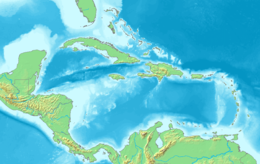 The island of Redonda, viewed from the south in 2023 | |
 Redonda highlighted in Antigua and Barbuda | |
| Geography | |
|---|---|
| Location | Caribbean Sea |
| Coordinates | 16°56′18″N 62°20′42″W / 16.93833°N 62.34500°W |
| Archipelago | Leeward Islands, Lesser Antilles |
| Length | 1.6 km (0.99 mi) |
| Width | 0.5 km (0.31 mi) |
| Highest elevation | 296 m (971 ft) |
| Administration | |
| Parish | Saint John[1] |
| Demographics | |
| Population | 0 |
| Additional information | |
| Time zone | |
Redonda is an uninhabited Caribbean island which is a dependency of Saint John, Antigua and Barbuda,[2] in the Leeward Islands, West Indies. The island is about 1.6 kilometres (1 mi) long, 0.5 kilometres (0.3 mi) wide, and is 296 metres (971 ft) high at its highest point.[3]
It lies between the islands of Nevis and Montserrat, 56.2 kilometres (34.9 mi) southwest of Antigua. Redonda is closer to Montserrat than to any other island; it is located 22.5 kilometres (14.0 mi) northwest of Montserrat and 32 kilometres (20 mi) southeast of Nevis.
Redonda is home to vast numbers of sea birds, and the island was an important source of guano before artificial fertilisers started to be mass-produced. Guano-mining operations started in the 1860s and ceased after the start of World War I. During the mining operations a few buildings and other installations were put in place on the island, and some physical remnants of that phase in its history are still visible.
"Redonda" is the feminine form of the Spanish language adjective meaning "round". In 1493, on his second voyage to the New World, Christopher Columbus saw the island and named it "Santa María la Redonda" (the name in the Spanish language means "Saint Mary the Round").
The island was annexed by the Antiguan Parish of Saint John on 26 March 1872.[1]
- ^ a b "The Redonda Annexation Act" (PDF). laws.gov.ag. 26 March 1872. Archived (PDF) from the original on 26 March 2023. Retrieved 21 August 2023.
- ^ "Government of Antigua and Barbuda". www.ab.gov.ag. Retrieved 11 July 2017.
- ^ "Antigua and Barbuda: Redonda". www.antiguanice.com. Retrieved 11 July 2017.


